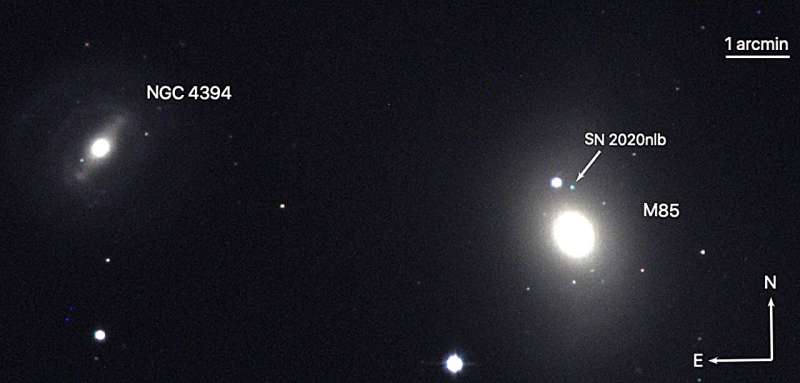Image of SN 2020nlb in its environment. Credit: arXiv (2024). DOI: 10.48550/arxiv.2401.08759
Using various ground-based telescopes, astronomers have performed photometric and spectroscopic observations of a nearby Type Ia supernova known as SN 2020nlb. Results of the observations campaign, presented January 16 on the pre-print server arXiv, deliver important insights regarding the evolution of this stellar explosion.
Type Ia supernovae (SN Ia) are found in binary systems in which one of the stars is a white dwarf. Stellar explosions of this type are important for the scientific community, as they offer essential clues into the evolution of stars and galaxies.
SN 2020nlb was detected on June 25, 2020 with the Asteroid Terrestrial-impact Last Alert System (ATLAS), shortly after its explosion in the lenticular galaxy Messier 85 (or M85 for short), located some 60 million light years away. Spectroscopic observations of SN 2020nlb, commenced shortly after its detection, confirmed that it is a Type Ia supernova.
A team of astronomers led by Steven Williams of the University of Turku, Finland, began to monitor SN 2020nlb 16 hours after it was discovered. The observations, using mainly the Liverpool Telescope (LT) and Nordic Optical Telescope (NOT), provided a wealth of data about the properties of this supernova.
"Here we present observations that include one of the earliest high-quality spectra and some of the earliest multi-color photometry of an SN Ia to date," the researchers wrote.
The photometric and spectroscopic observations conducted by Williams' team lasted until almost 600 days after the explosion of SN 2020nlb. It was estimated that the supernova was discovered just two days after its first light.
The observations found that SN 2020nlb faded 1.28 mag in the B band during the first 15 days after maximum brightness. Therefore, it was declining faster than an average normal Type Ia supernova, which suggests that it has a lower luminosity than the typical SNe of this class.
The spectrum of SN 2020nlb taken nearly three days after the first light shows strong features from singly ionized metals. Moreover, a nebular spectrum taken 594 days after the maximum light shows that the strong iron emission line had disappeared, with the ionization balance of the ejecta falling.
The earliest spectra of SN 2020nlb resembled the maximum-light spectra of SN 1991bg, and similar supernovae. Afterward, the spectra of SN 2020nlb evolved to become hotter and more similar to SN 2011fe as it brightened towards peak.
According to the authors of the paper, the nebular spectra of SN 2020nlb, when compared to other SNe Ia nebular spectra point to a possible trend where SNe that were more luminous at peak tend to have higher ionization in the nebular phase. This may indicate that there is something fundamentally different about SN 2020nlb and similar SNe than the bulk of the normal SN Ia population.
More information: S. C. Williams et al, Observations of type Ia supernova SN 2020nlb up to 600 days after explosion, and the distance to M85, arXiv (2024). DOI: 10.48550/arxiv.2401.08759
Journal information: arXiv
© 2024 Science X Network























